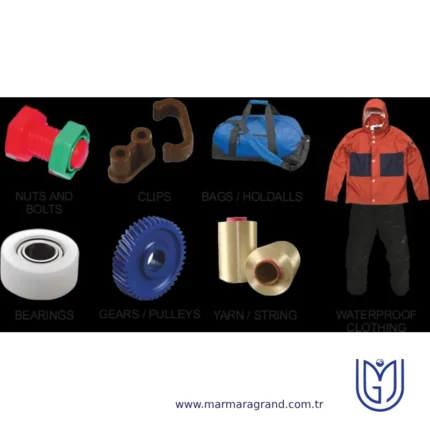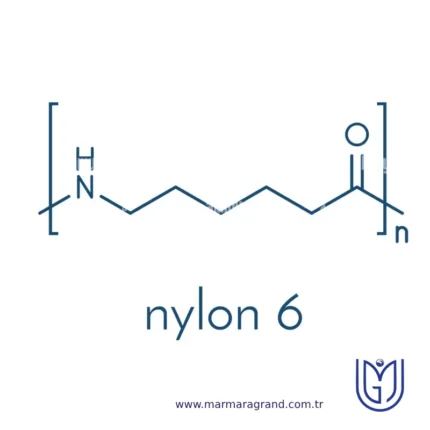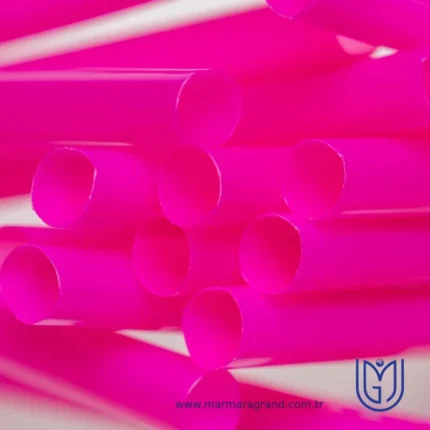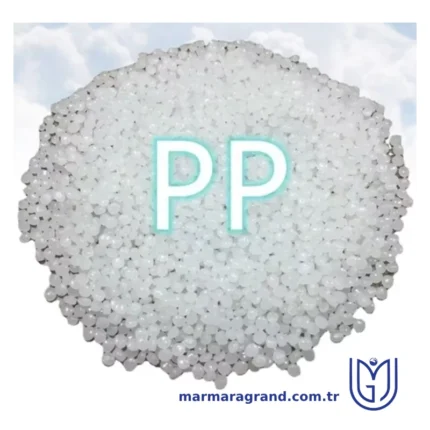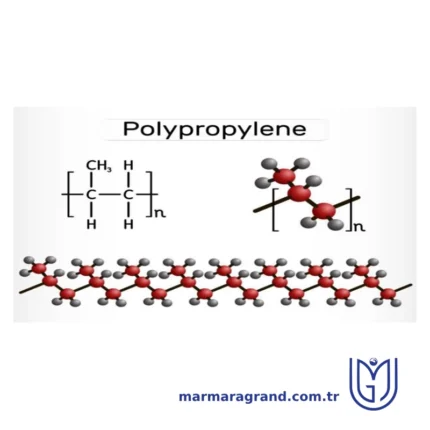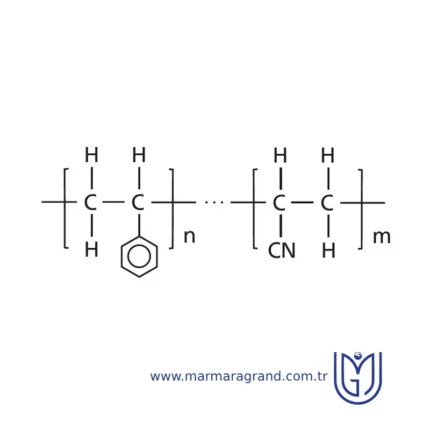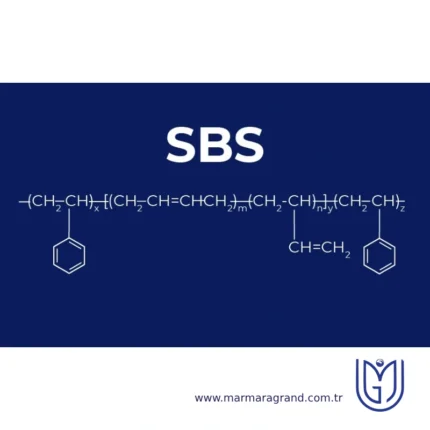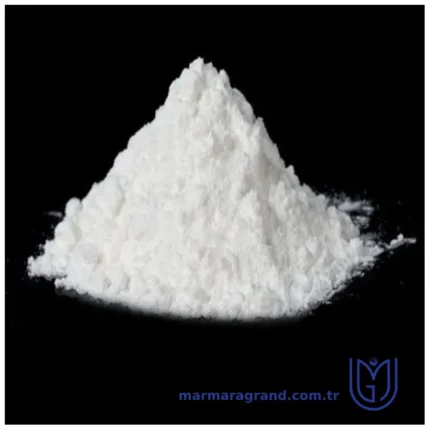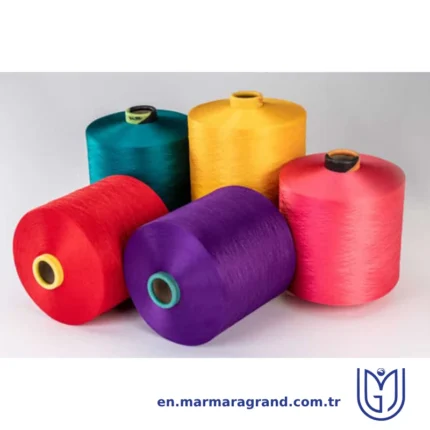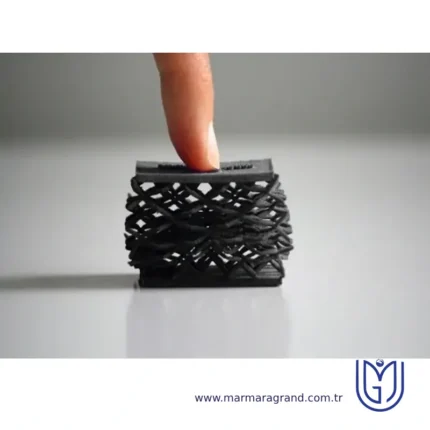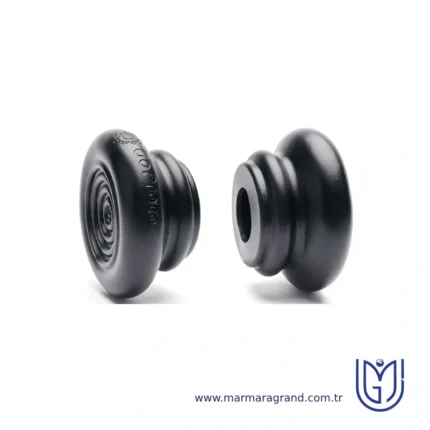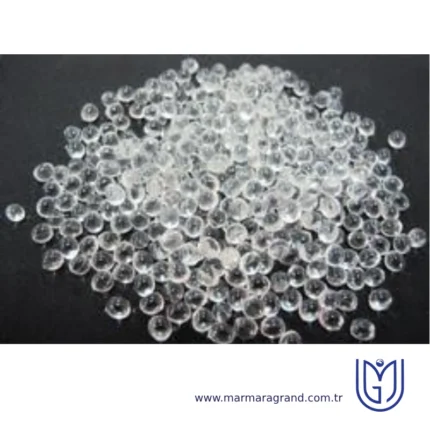Nylon 6
Nylon 6 is a synthetic engineering thermoplastic belonging to the polyamide (PA) family. It is widely used for its high strength, durability, thermal resistance, and chemical stability. Nylon 6 is synthesized from a single monomer, caprolactam, through ring-opening polymerization. This makes Nylon 6 easier to produce and process.
PropertiesNylon 6 is a strong, lightweight, and durable engineering thermoplastic known for its excellent mechanical and thermal properties. It has high tensile strength, toughness, and impact resistance, making it suitable for demanding applications. It also exhibits good wear resistance, low friction, and excellent abrasion resistance, which enhances its longevity in mechanical parts. Nylon 6 has a melting point of approximately 220°C and maintains stability over a wide temperature range. It offers good chemical resistance to oils, greases, and many solvents but is sensitive to strong acids and bases. One of its notable characteristics is its high moisture absorption, which can affect its mechanical strength and dimensional stability. Nylon 6 also has good electrical insulating properties, making it useful in electrical and electronic applications. Additionally, it is easily processable through injection molding, extrusion, and fiber spinning, allowing for its widespread use in textiles, automotive components, and industrial applications.
StructureNylon 6 is a synthetic polymer belonging to the polyamide family, characterized by its repeating units derived from caprolactam through a ring-opening polymerization process. The molecular structure of Nylon 6 consists of a linear chain of amide (–CONH–) linkages interspersed with six-carbon alkyl segments, forming a highly regular and symmetrical backbone that contributes to its notable mechanical strength, thermal stability, and chemical resistance. Unlike Nylon 6,6, which is synthesized from two different monomers, Nylon 6 is synthesized from a single monomer, ε-caprolactam, which undergoes polymerization through successive opening of the lactam ring, resulting in a continuous chain structure. The presence of hydrogen bonding between adjacent polymer chains enhances intermolecular interactions, leading to high crystallinity and improved tensile properties. This structural arrangement imparts Nylon 6 with desirable characteristics such as high flexibility, durability, and resistance to abrasion, making it widely utilized in textiles, engineering plastics, and industrial applications.
Applications of Nylon 6
- Textiles and Fabrics: Nylon 6 is widely used in the textile industry to produce items such as hosiery, swimwear, activewear, and undergarments due to its elasticity, strength, and smooth texture.
- Industrial Uses: Its high tensile strength and abrasion resistance make Nylon 6 suitable for manufacturing ropes, fishing nets, conveyor belts, and tire cords.
- Automotive Components: Nylon 6 is utilized in producing various automotive parts, including gears, bearings, and under-the-hood components, because of its durability and thermal stability.
- Consumer Goods: Common household items like toothbrush bristles, combs, and kitchen utensils are often made from Nylon 6 due to its resilience and ease of molding.
- Engineering Plastics: Nylon 6 is used in the production of engineering plastics for applications such as gears, bearings, and other mechanical components, owing to its strength and wear resistance.
Advantages of Nylon 6
- High Strength and Durability: Nylon 6 exhibits excellent tensile strength, making it suitable for products requiring long-lasting performance.
- Flexibility and Elasticity: The material offers good flexibility and can return to its original shape after stretching, which is beneficial for textile applications.
- Chemical Resistance: Nylon 6 is resistant to a wide range of chemicals, including oils and solvents, enhancing its suitability for various industrial applications.
- Thermal Resistance: With a high melting point, Nylon 6 can withstand elevated temperatures, making it appropriate for applications involving heat exposure.
- Lightweight: Nylon 6 is lighter than many metals, which is advantageous in applications where weight reduction is desired.
Disadvantages of Nylon 6
- Moisture Absorption: Nylon 6 is hygroscopic and can absorb moisture from the environment, leading to dimensional changes and potential degradation of mechanical properties.
- UV Sensitivity: Prolonged exposure to ultraviolet light can cause Nylon 6 to degrade, leading to discoloration and loss of strength.
- Lower Impact Resistance: Compared to some other engineering plastics, Nylon 6 may exhibit lower impact resistance, which could limit its use in high-impact applications.
- Processing Challenges: Nylon 6 requires careful control during processing, as it is sensitive to moisture and can degrade if not properly dried before molding.
PolyArylEtherKetone (PAEK)
PolyArylEtherKetone (PAEK) is a family of high-performance, semi-crystalline thermoplastics known for their excellent mechanical properties, thermal stability, and chemical resistance. These polymers contain aromatic rings connected by ether (-O-) and ketone (-CO-) linkages, which contribute to their strength and durability.
Structure
The structure of PolyArylEtherKetone (PAEK) consists of a repeating backbone of aromatic rings (aryl groups) connected by ether (-O-) and ketone (-CO-) linkages. These alternating ether and ketone groups provide a unique combination of flexibility and rigidity, contributing to the polymer's high thermal stability, chemical resistance, and mechanical strength. The presence of aromatic rings enhances structural integrity, making the polymer highly resistant to degradation under extreme conditions. The ether linkages add flexibility to the molecular chain, improving processability, while the ketone groups increase the polymer’s resistance to heat and oxidation. The semi-crystalline nature of PAEK arises from the ability of the polymer chains to pack efficiently in an ordered manner, leading to excellent wear resistance and high mechanical performance. Different types of PAEK, such as PEEK, PEK, and PEKK, vary in the arrangement and proportion of these functional groups, influencing their thermal and mechanical properties. This unique molecular structure makes PAEK an ideal choice for high-performance applications in aerospace, medical, automotive, and industrial sectors.
Properties
PolyArylEtherKetone (PAEK) is a high-performance, semi-crystalline thermoplastic known for its exceptional mechanical, thermal, and chemical properties. It exhibits excellent strength, stiffness, and wear resistance, making it ideal for demanding applications in aerospace, automotive, medical, and oil and gas industries. PAEK has outstanding thermal stability, withstanding continuous use temperatures of up to 250°C, while also demonstrating remarkable resistance to chemicals, including acids, bases, and organic solvents. It possesses low moisture absorption, ensuring dimensional stability even in humid environments. Furthermore, PAEK offers excellent fatigue resistance, making it suitable for long-term load-bearing applications. Its inherent flame retardancy and low smoke emission enhance safety in high-temperature environments. Additionally, PAEK maintains excellent electrical insulation properties, making it valuable for electronic and electrical applications. These unique characteristics make PAEK an advanced material choice for extreme engineering conditions.
Applications of PolyArylEtherKetone (PAEK):
- Aerospace & Automotive: Used in structural components, bearings, and bushings due to its lightweight, high strength, and temperature resistance.
- Medical Devices: Ideal for implants, surgical instruments, and dental components due to biocompatibility and sterilization resistance.
- Oil & Gas Industry: Used in seals, valves, and insulators for its excellent chemical and high-temperature resistance.
- Electronics & Electrical: Utilized in connectors, insulators, and semiconductor manufacturing for its electrical insulation and heat resistance.
- Industrial & Manufacturing: Used in gears, pumps, and wear-resistant parts due to its high mechanical strength and low friction.
- High Thermal Stability: Can withstand continuous temperatures up to 250°C.
- Excellent Mechanical Properties: High strength, stiffness, and impact resistance.
- Chemical Resistance: Withstands harsh chemicals, acids, and solvents.
- Low Moisture Absorption: Ensures dimensional stability in humid environments.
- Good Wear & Fatigue Resistance: Ideal for long-term, high-load applications.
- Flame Retardant & Low Smoke Emission: Enhances safety in high-temperature applications.
- Biocompatibility: Suitable for medical implants and surgical devices.
- High Cost: More expensive than conventional plastics and some high-performance polymers.
- Difficult Processing: Requires high temperatures and specialized equipment for manufacturing.
- Limited Availability: Not as widely produced as other engineering plastics, leading to supply constraints.
- Brittleness at Low Temperatures: Can become less impact-resistant in extreme cold conditions.
PolyPropylene (PP Chemical)
Polypropylene (PP) is one of the most widely used thermoplastic polymers, known for its high strength, chemical resistance, and versatility. It is used in industries ranging from packaging and textiles to automotive and medical applications.
Structure of Polypropylene (PP)Polypropylene (PP) is a semi-crystalline thermoplastic polymer derived from propene (C₃H₆) monomers through the polymerization process.
- Molecular Structure:
- Composed of repeating propylene units (C₃H₆) linked together in a chain-like structure.
- Exists in three main forms:
- Isotactic PP – Most commonly used, with all methyl groups (CH₃) aligned on one side of the polymer chain, resulting in high crystallinity and strength.
- Syndiotactic PP – Alternating arrangement of methyl groups, making it more flexible but less crystalline.
- Atactic PP – Random arrangement of methyl groups, leading to an amorphous structure with low strength.
- Polymerization Process:
- Polypropylene is synthesized using Ziegler-Natta catalysts or metallocene catalysts in industrial polymerization reactions.
- It is classified as a thermoplastic, meaning it can be melted and reshaped multiple times without significant degradation.
Properties of Polypropylene (PP)Polypropylene possesses a combination of mechanical, thermal, and chemical properties, making it ideal for diverse applications.
1. Mechanical Properties:
✔ High Tensile Strength – Strong yet lightweight, making it ideal for packaging and textiles. ✔ Impact Resistance – Can withstand moderate shocks and impacts. ✔ Good Elasticity & Flexibility – Suitable for films, fibers, and flexible containers.2. Thermal Properties:
✔ High Melting Point (~160°C – 170°C) – More heat-resistant than polyethylene (PE). ✔ Low Thermal Conductivity – Acts as an insulating material. ✔ Resistant to Temperature Fluctuations – Can handle both hot and cold environments.3. Chemical Properties:
✔ Resistant to Acids, Alkalis, and Solvents – Does not degrade easily when exposed to chemicals. ✔ Low Water Absorption – Maintains mechanical properties in humid environments. ✔ Good Fatigue Resistance – Ideal for repeated bending applications like hinges.4. Electrical Properties:
✔ Excellent Electrical Insulation – Used in wires, cables, and electrical components.5. Environmental Properties:
✔ Recyclable (#5 plastic code) – Can be reused in eco-friendly applications. ✔ UV Sensitivity – Can degrade when exposed to prolonged UV radiation unless treated with stabilizers.Applications of Polypropylene (PP)
- Packaging Industry
- Textile Industry
- Automotive Industry
- Medical & Healthcare Applications
- Household & Consumer Products
- Industrial Applications
Advantages of Polypropylene (PP)✔ Lightweight & Strong – Provides durability without adding extra weight. ✔ Excellent Chemical Resistance – Withstands exposure to acids, bases, and solvents. ✔ High Heat Resistance – Can be used in microwaves and hot water applications. ✔ Waterproof & Moisture-Resistant – Ideal for food packaging and textiles. ✔ Recyclable & Eco-Friendly – Can be reused, reducing plastic waste. ✔ Affordable & Cost-Effective – Inexpensive compared to other polymers. ✔ Non-Toxic & Safe – Used in medical and food-grade applications.
Disadvantages of Polypropylene (PP)✘ UV Degradation – Can become brittle when exposed to sunlight for long periods unless UV stabilizers are added. ✘ Low Impact Resistance at Low Temperatures – Can crack in extremely cold conditions. ✘ Flammability – Easily combustible and requires flame retardants for certain applications. ✘ Difficult to Paint or Glue – Requires special surface treatments for adhesion. ✘ Limited Transparency – Unlike PET, PP is not completely clear. ✘ Environmental Concerns – Though recyclable, it is not biodegradable, leading to plastic waste issues.
Styrene AcryloNitrile SAN
SAN polymer, with the chemical name styrene-acrylonitrile copolymer, is a versatile plastic that is characterised above all by its excellent transparency and chemical resistance. In addition, it has high stiffness and good dimensional stability which allow it to be used in demanding environments.
styrene acrylonitrile structureStyrene acrylonitrile resin (SAN) is a copolymer plastic consisting of styrene and acrylonitrile. The typical composition of SAN polymers is:
- Styrene: ~70–80%
- Acrylonitrile: ~20–30%
styrene acrylonitrile resin propertiesSAN is similar in use to polystyrene. Like polystyrene itself, it is transparent and brittle. The copolymer has a glass transition temperature greater than 100 °C owing to the acrylonitrile units in the chain, thus making the material resistant to boiling water. SAN is known for its excellent tensile and flexural strength, which makes it suitable for structural applications. It resists oils, fats, dilute acids, and alkalis, making it suitable for use in chemical containers and food storage.
styrene acrylonitrile applicationsHousehold Products: Plastic tumblers, food trays, storage containers Automotive: Interior components, knobs, handles, instrument panels Medical: Test tubes, Petri dishes, laboratory equipment Electronics: Housings, enclosures, transparent electronic parts
Advantages
- High Mechanical Strength
- Ease of Processing
- Lightweight
- Cost-Effective
- Transparency
- Good Electrical Insulation
Disadvantages
- Limited Impact Strength
- Environmental Stress Cracking
- Flammability
- Limited Weatherability
Styrenic Block Copolymers (TPS)
Styrenic Block Copolymers (TPS) are a class of thermoplastic elastomers (TPEs) composed of alternating hard and soft polymer segments. The hard segments are made of polystyrene (PS), while the soft segments consist of rubber-like elastomers such as polybutadiene (PB) or polyisoprene (PI). This structure gives TPS materials the elasticity of rubber while maintaining the easy processability of thermoplastics.
StructureStyrenic block copolymers (TPS) have a phase-separated structure composed of alternating hard and soft polymer segments. The hard segments consist of polystyrene (PS) domains, which provide strength, rigidity, and thermal stability, while the soft segments are made of elastomeric materials such as polybutadiene (PB), polyisoprene (PI), or ethylene-butylene (EB), contributing to flexibility and elasticity. These block copolymers form a physical crosslinking network where the polystyrene blocks aggregate into discrete domains, acting as physical anchors that hold the material together, while the rubbery segments remain continuous and provide elasticity. This unique morphology allows TPS materials to behave like thermoset elastomers at room temperature but soften and flow when heated, making them fully thermoplastic and easily reprocessable. The phase separation between the polystyrene and elastomeric segments gives TPS its characteristic combination of strength, flexibility, and processability, making it widely used in applications requiring both durability and soft-touch properties.
PropertiesStyrenic block copolymers (TPS) exhibit a unique combination of elasticity, strength, and processability due to their phase-separated structure. They have excellent flexibility and rubber-like elasticity, allowing them to stretch and recover their shape without permanent deformation. Their mechanical properties include good tensile strength and impact resistance, making them durable for various applications. TPS materials have moderate heat resistance, generally performing well below 100°C, and are resistant to many oils, greases, and chemicals, enhancing their stability in demanding environments. They also have good adhesion properties, making them suitable for overmolding onto other plastics. Unlike thermoset rubbers, TPS materials are thermoplastic, meaning they can be melted, reshaped, and recycled multiple times, improving manufacturing efficiency and sustainability. They also provide a soft-touch feel, making them ideal for grips, handles, and other ergonomic applications. Additionally, TPS offers good weather resistance, especially in formulations like SEBS, which enhance UV and oxidation stability. These combined properties make TPS widely used in automotive, medical, consumer goods, and adhesive applications.
Application
- Automotive Industry:
- Soft-touch interior components (dashboards, door panels)
- Seals, gaskets, and vibration dampeners
- Grip pads and protective coatings
- Consumer Goods:
- Handles and grips for tools, toothbrushes, and razors
- Sports equipment, shoe soles, and protective gear
- Flexible packaging and stretchable films
- Medical Applications:
- Medical tubing and syringe plungers
- Overmolded soft-touch medical devices
- Flexible, biocompatible components
- Adhesives and Sealants:
- Pressure-sensitive adhesives (PSAs)
- Hot-melt adhesives for packaging and footwear
- Electronics & Electrical:
- Protective casings for devices
- Wire and cable insulation
AdvantagesHigh Elasticity and Flexibility – Provides rubber-like stretch and softness Good Impact and Tensile Strength – Enhances durability and wear resistance Thermoplastic Nature – Can be easily melted, reshaped, and recycled Soft-Touch Feel – Ideal for ergonomic grips and overmolding Good Adhesion to Various Materials – Suitable for multi-material applications Resistant to Oils, Greases, and Chemicals – Performs well in harsh environments Lightweight – Reduces material costs and improves energy efficiency Good Weather and UV Resistance – Certain formulations (e.g., SEBS) have enhanced outdoor durability Easy Processing – Compatible with injection molding, extrusion, and blow molding
DisadvantagesLower Heat Resistance – Limited performance above 100°C Lower Stiffness Compared to Some Plastics – May require reinforcement for structural applications Can Become Sticky in Hot Conditions – Some grades may soften and lose shape retention Higher Cost Than Standard Plastics – More expensive than traditional polyolefins like PP and PE Limited Load-Bearing Capacity – Not suitable for heavy-duty mechanical applications
Suspension
Polyvinyl Chloride (PVC) Suspension Grade is one of the most widely used thermoplastic polymers, produced through the suspension polymerization process. This method results in free-flowing, fine particles that can be processed into various products. Suspension PVC (S-PVC) is known for its versatility, chemical resistance, durability, and cost-effectiveness, making it a popular choice in multiple industries.
StructurePolyvinyl Chloride (PVC) suspension grade is a thermoplastic polymer produced through the suspension polymerization process. In this method, vinyl chloride monomer (VCM) is dispersed in water with the help of suspending agents and polymerized using free radical initiators. The resulting PVC resin consists of fine, porous, and free-flowing particles with a relatively high molecular weight, making it suitable for a wide range of applications. The polymer structure is primarily composed of repeating vinyl chloride units (–CH₂–CHCl–), forming a linear polymer chain with varying degrees of polymerization. PVC suspension grade is widely used in the manufacturing of pipes, fittings, films, sheets, and rigid as well as flexible products due to its excellent mechanical strength, durability, and chemical resistance. The properties of the resin, such as particle size, porosity, and bulk density, can be adjusted by controlling the polymerization conditions, making it versatile for different industrial applications.
PropertiesPVC suspension grade exhibits a combination of excellent physical, mechanical, and chemical properties, making it highly versatile for industrial applications. It appears as a white, free-flowing powder with a bulk density ranging from 0.45 to 0.65 g/cm³ and a particle size typically between 50-250 microns. Its high porosity allows for better plasticizer absorption, making it suitable for both rigid and flexible products. Mechanically, it offers good tensile strength, typically between 40-60 MPa, and moderate to high impact resistance, which can be enhanced with additives. Chemically, PVC suspension grade is highly resistant to acids, bases, and many chemicals, ensuring durability in harsh environments. It also has low water absorption, which provides excellent dimensional stability. However, it is susceptible to UV degradation, requiring stabilizers for outdoor applications. These properties make PVC suspension grade ideal for manufacturing pipes, profiles, films, and various other rigid and flexible products.
Applications
- Construction Industry: Pipes, fittings, window profiles, doors, roofing sheets
- Packaging Industry: Films, sheets, bottles
- Automotive Industry: Interior trims, dashboards, wire insulation
- Medical Sector: Tubing, blood bags, IV containers
- Electrical Applications: Cable insulation, coatings
Advantages
- High durability and strength – Ideal for long-term use
- Excellent chemical resistance – Withstands acids, bases, and oils
- Cost-effective – Affordable compared to other polymers
- Low water absorption – Ensures dimensional stability
- Easily processable – Can be molded, extruded, and shaped easily
- Customizable – Properties can be modified with additives
Disadvantages
- UV degradation – Becomes brittle under prolonged sunlight exposure
- Toxic gas release – Emits harmful gases (HCl) when burned
- Health concerns – Some plasticizers used in flexible PVC may have risks
- Not biodegradable – Raises environmental concerns regarding disposal
Textile Grade
Textile grade refers to materials that are specifically designed and processed for textile applications, ensuring optimal performance in fabric production. These materials can be natural (like cotton, wool, silk) or synthetic (like polyester, nylon, acrylic).
- Molecular Structure:
- Natural fibers have a cellulose-based (plant fibers) or protein-based (animal fibers) molecular structure.
- Synthetic fibers are often derived from polymer chains, such as polyethylene terephthalate (PET) in polyester.
- Fiber Morphology:
- Fibers are classified as filament (long, continuous fibers like silk) or staple (short fibers like cotton).
- Processing techniques such as spinning, weaving, and knitting alter fiber orientation for enhanced strength and flexibility.
- Surface Treatment:
- Textile grade materials undergo chemical treatments such as dyeing, anti-static coating, moisture-wicking finishes, and UV protection to enhance their functionality.
PropertiesTextile grade materials possess distinct characteristics that make them suitable for various applications:
1. Mechanical Properties
✔ High Tensile Strength – Ensures durability and resistance to tearing. ✔ Elasticity – Some fibers (like spandex) stretch and recover their shape. ✔ Abrasion Resistance – Important for heavy-use applications like upholstery and workwear.2. Thermal Properties
✔ Heat Resistance – Some fibers (e.g., aramid, wool) withstand high temperatures. ✔ Low Melting Point – Certain synthetics (e.g., polyester) require controlled heat processing.3. Chemical Properties
✔ Moisture-Wicking – Polyester and nylon repel moisture, keeping fabrics dry. ✔ Chemical Resistance – Some textile grades resist acids, alkalis, and solvents. ✔ UV Protection – Certain fibers (e.g., acrylic) naturally block UV rays.4. Environmental Properties
✔ Biodegradability – Natural fibers decompose over time, unlike synthetics. ✔ Sustainability – Eco-friendly textile grades include organic cotton, recycled polyester, and bamboo fibers.ApplicationsTextile grade materials are used across multiple industries, including fashion, home textiles, and technical applications.
1. Apparel Industry
- Clothing – Shirts, pants, jackets, and sportswear.
- Performance Fabrics – Moisture-wicking athletic wear, compression garments.
- Luxury Textiles – Silk, high-thread-count cotton, and premium synthetic blends.
2. Home Textiles
- Upholstery – Durable fabrics for sofas, curtains, and carpets.
- Bedding – Sheets, blankets, and pillowcases.
- Towels & Linens – Cotton-based materials for comfort and absorbency.
3. Industrial & Technical Textiles
- Automotive Textiles – Car seats, airbags, and interior linings.
- Medical Textiles – Surgical gowns, bandages, and antimicrobial fabrics.
- Protective Gear – Fire-resistant clothing (e.g., Nomex), bulletproof vests (Kevlar).
4. Eco-Friendly & Sustainable Applications
- Recycled Textiles – Upcycled polyester from plastic bottles.
- Organic Fibers – Bamboo, hemp, and organic cotton for sustainable fashion.
AdvantagesDurability – Textile grade materials are engineered for longevity. Versatility – Suitable for various applications, from fashion to industry. Lightweight & Comfortable – Many textiles are breathable and easy to wear. Easy Maintenance – Many fibers resist stains, wrinkles, and shrinkage. Cost-Effective – Mass production of synthetics reduces costs. Sustainability Options – Growing availability of eco-friendly textile grades.
DisadvantagesEnvironmental Concerns – Many synthetic fibers are non-biodegradable and contribute to plastic pollution. Flammability – Some textiles require fire-resistant treatments for safety. Chemical Sensitivity – Certain materials degrade when exposed to strong detergents, acids, or UV light. Heat Sensitivity – Synthetic fibers like polyester melt at high temperatures, limiting ironing options. Moisture Absorption Issues – Some fibers retain or repel moisture excessively, impacting comfort.
Thermoplastic PolyAmide elastomer (TPA)
Thermoplastic Polyamide Elastomer (TPA) is a type of thermoplastic elastomer (TPE) that combines the flexibility and elasticity of elastomers with the strength and processability of thermoplastics. TPAs are composed of alternating soft and hard segments, where the soft segments provide elasticity, while the hard segments (typically polyamide-based) contribute to mechanical strength and thermal stability.
StructureThe structure of Thermoplastic Polyamide Elastomer (TPA) consists of a phase-separated morphology with alternating soft and hard segments. The soft segments are typically composed of polyether or polyester chains, which provide flexibility, elasticity, and low-temperature performance. The hard segments are derived from polyamide (nylon) components, contributing to mechanical strength, chemical resistance, and thermal stability. This block copolymer structure allows TPAs to exhibit both rubber-like elasticity and thermoplastic processability. The hard polyamide domains act as physical crosslinks, reinforcing the material and providing shape stability, while the soft segments allow for stretchability and energy absorption. This unique microstructure enables TPAs to maintain excellent mechanical properties while being reprocessable and recyclable like conventional thermoplastics.
PropertiesThermoplastic Polyamide Elastomer (TPA) exhibits a unique combination of flexibility, strength, and chemical resistance, making it a highly versatile material. It possesses high elasticity and excellent recovery, allowing it to behave like rubber while maintaining thermoplastic processability. TPAs offer superior mechanical strength, abrasion resistance, and durability, making them suitable for demanding applications. They also demonstrate outstanding chemical and oil resistance, particularly against fuels, solvents, and industrial chemicals, which enhances their performance in harsh environments. Additionally, TPAs have good thermal stability, allowing them to withstand a wide range of temperatures without significant degradation. However, due to their hygroscopic nature, they tend to absorb moisture from the environment, requiring proper drying before processing. Despite this, their lightweight nature, recyclability, and ease of processing through standard thermoplastic methods such as injection molding and extrusion make TPAs an attractive choice for various industries, including automotive, electronics, and medical applications.
Applications of TPA
- Automotive: Fuel lines, air ducts, seals, gaskets, and hoses.
- Electronics: Wire insulation, connectors, and protective casings.
- Medical Devices: Tubing, catheters, flexible components, and grips.
- Industrial Machinery: Conveyor belts, seals, vibration dampeners, and flexible couplings.
- Sports & Consumer Goods: Shoe soles, flexible grips, protective gear, and wear-resistant textiles.
Advantages of TPAHigh chemical and oil resistance – Withstands fuels, solvents, and industrial chemicals. Excellent mechanical strength – Offers toughness, durability, and abrasion resistance. Good flexibility and elasticity – Provides rubber-like properties with thermoplastic processing benefits. Wide temperature range stability – Performs well in both high and low temperatures. Lightweight and recyclable – More sustainable compared to traditional rubber. Easy processing – Can be injection molded, extruded, or blow molded.
Disadvantages of TPAHigher cost – More expensive than standard thermoplastic elastomers (TPEs). Hygroscopic nature – Absorbs moisture, requiring drying before processing. Lower flexibility than fully vulcanized rubber – May not match the elasticity of certain elastomers. Limited UV resistance – Some grades may require UV stabilizers for outdoor applications.
Thermoplastic PolyOlefins (TPO)
Thermoplastic Polyolefins (TPO) are a class of polyolefin-based thermoplastic elastomers that combine the properties of polypropylene (PP), polyethylene (PE), and elastomers. They are widely used in various industries due to their durability, flexibility, chemical resistance, and ease of processing.
StructureThermoplastic polyolefins (TPOs) have a heterogeneous polymer structure, consisting of a semi-crystalline polypropylene (PP) matrix blended with amorphous elastomeric domains, typically ethylene-propylene-diene monomer (EPDM) or ethylene-propylene rubber (EPR). The PP component provides rigidity, thermal stability, and strength, while the elastomeric phase contributes flexibility, impact resistance, and toughness. Unlike copolymers, TPOs maintain a phase-separated microstructure, where the rubber particles are dispersed within the PP matrix rather than chemically bonded. This structure allows TPOs to remain thermoplastic, meaning they can be melted and reprocessed without undergoing permanent chemical cross-linking. Additionally, the presence of optional fillers such as talc, glass fibers, or carbon black can modify properties like stiffness and durability. The balance between the crystalline regions of PP and the amorphous elastomer phase gives TPOs their unique combination of strength, flexibility, and recyclability, making them ideal for applications in automotive parts, roofing membranes, and flexible packaging materials.
PropertiesThermoplastic Polyolefins (TPOs) possess a unique combination of mechanical, thermal, chemical, and electrical properties that make them highly versatile in various applications. Mechanically, they offer high impact resistance, good flexibility, and moderate stiffness, thanks to the combination of a semi-crystalline polypropylene (PP) matrix and elastomeric components such as ethylene-propylene rubber (EPR) or EPDM. They also exhibit excellent tear and abrasion resistance, making them durable in demanding environments. Thermally, TPOs can withstand temperatures up to 120–140°C, with a relatively low melting point (~165°C for the PP phase), allowing for easy processing via injection molding, extrusion, and thermoforming. Chemically, they are highly resistant to oils, greases, solvents, acids, and bases, and with proper stabilization, they offer good UV and weather resistance, making them suitable for outdoor applications such as automotive exteriors and roofing membranes. Additionally, TPOs have low water absorption, ensuring dimensional stability in humid conditions. Electrically, they function as good insulators, making them useful in select wire and cable applications. Their thermoplastic nature allows for melting and reshaping, making them highly recyclable and environmentally friendly compared to traditional thermoset rubbers. Moreover, TPOs are lightweight, contributing to fuel efficiency in automotive applications and reducing material costs. These combined properties make TPOs ideal for automotive bumpers, flexible packaging, consumer goods, and construction materials.
Applications of Thermoplastic PolyOlefins
- Automotive Industry:
- Bumpers and fascias
- Interior trim panels and dashboard components
- Weather seals and underbody shields
- Lightweight structural parts for fuel efficiency
- Roofing & Construction:
- TPO roofing membranes (waterproof and UV-resistant)
- Flexible building materials and siding
- Window and door seals
- Consumer Goods:
- Sporting equipment (e.g., soft-touch grips, protective gear)
- Medical components (due to chemical resistance)
- Household items like storage bins and furniture components
- Packaging Industry:
- Rigid and flexible food containers
- Industrial packaging solutions
- Electrical & Electronics:
- Wire and cable insulation
- Protective casings for devices
Advantages of Thermoplastic PolyOlefinsHigh Impact Resistance – Absorbs shocks and mechanical stress effectively Flexible Yet Durable – Balances elasticity with structural integrity Excellent Weather & UV Resistance – Ideal for outdoor applications Good Chemical & Water Resistance – Resists oils, solvents, and moisture Lightweight – Reduces material costs and improves fuel efficiency in vehicles Easy to Process & Mold – Can be injection molded, extruded, or thermoformed Thermoplastic & Recyclable – Can be reprocessed, making it an eco-friendly choice Cost-Effective – Lower production costs compared to thermoset rubbers
Disadvantages of Thermoplastic PolyOlefinsLower Heat Resistance – Limited to around 120–140°C, making it unsuitable for high-heat applications Lower Stiffness Compared to Some Plastics – May require reinforcement (e.g., glass fibers) for structural strength Surface Finish Limitations – May require coatings or treatments for improved aesthetics Difficult to Bond with Adhesives – Requires specialized bonding techniques due to low surface energy Can Become Brittle in Extreme Cold – Some formulations may lose flexibility at very low temperatures


